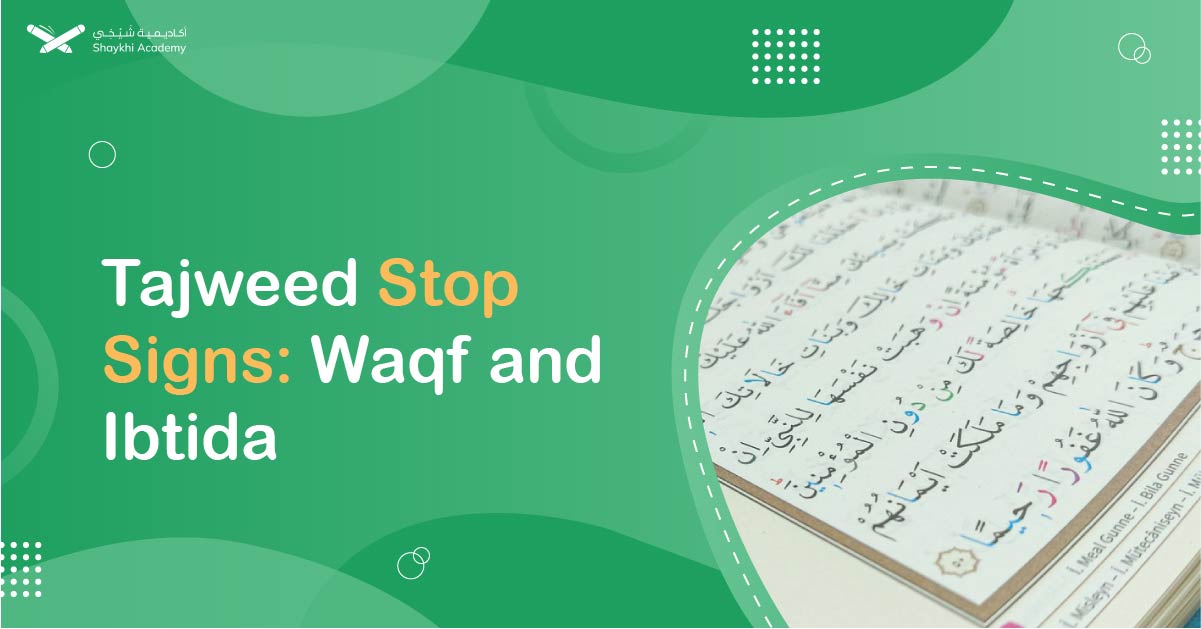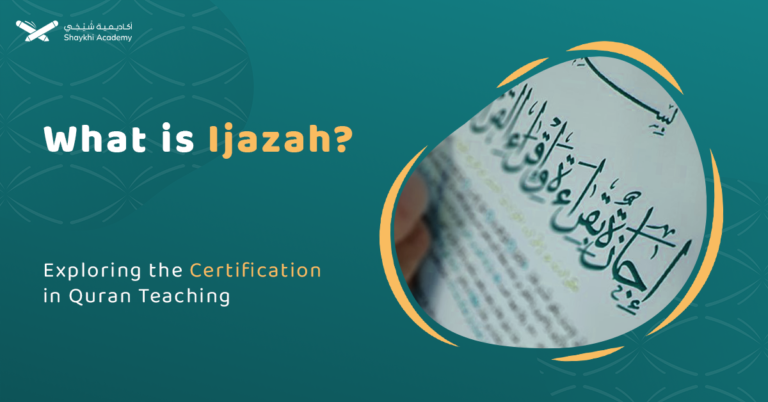Tajweed, the art of Quranic recitation, orchestrates pauses (Waqf) and restarts (Ibtida) to preserve its beauty and message. Waqf marks moments for reflection—forced by sneezes or chosen for learning—while Ibtida resumes with clarity, avoiding distortions. Symbols like “م” and “ط” guide these pauses, enhancing the rhythmic flow and deepening understanding, ensuring each verse is honored and remembered with reverence and precision.
Tajweed is the science that clarifies rules that must be adhered to when reciting the Holy Quran in accordance with what Muslims received from the Messenger of God, by giving each letter its due direction, adjective and vowel, without affectation or arbitrariness.
Tajweed has many rulings, including stopping and starting (Waqf and Ibtida), so what do they mean?
What are the Tajweed Quran Stop Signs?
Tajweed stop signs, known as Waqf and Ibtida, are crucial in Quranic recitation for maintaining correct pronunciation and understanding. Waqf denotes pauses: forced (involuntary stops like sneezing), voluntary (by choice, permissible or forbidden), waiting (for learning purposes), and test pauses (for assessment). Ibtida signifies starting after a pause, classified into good (non-contradictory beginnings) and ugly (distorted meanings).
Examples include symbols like “م” for mandatory pauses and “ط” for natural stops, each aiding in preserving the Quran’s message, ensuring rhythmic recitation, and fostering deeper contemplation of its verses. Learning these rules not only enhances recitation but also enriches spiritual engagement with the Quran’s profound teachings.
Waqf meaning
Pausing (Waqf) in the language means to stop something, but in Tajweed it means stopping the sound and being silent at the end of the word for a period of time during which the reader usually breathes with the intention of resuming reading again.
Types of Waqf in Tajweed
There are 4 divisions of Waqf in Tajweed:
1- Forced pause
This is when the reader stops without his will due to a temporary reason, such as sneezing, shortness of breath, coughing, forgetfulness, and so on.
2- Voluntary pause
1It means that the reader stops by choice and will, and it’s divided into two parts which are
Permissible optional pause
It means stopping at what has been done its meaning
A forbidden, impermissible pause
This means to stop on something whose meaning has not been fulfilled.
3- Waiting pause
This is the pause that occurs when reading more than one narration. The reader stops at a word to come up with the rest of the reading aspects that he wants to read before continuing the recitation. This pause is permissible when learning different readings.
4- Test pause
This is when the student stops at the request of his teacher to examine him and test his knowledge of how to stop.
Ibtida meaning
Beginning (Ibtida) is to begin reading after pausing or interrupting.
We can say that for Ibtida to occur, there must be a previous Waqf.
What is Ibtida meaning in Arabic?
Beginning in the Arabic language means starting something, and beginning comes in the sense of introducing something and doing it first. You say: I started with so-and-so, meaning: I introduced him, and the initiator is the one who precedes others, and the beginning: The Forerunner, First, and Opener of all things.
What is Ibtida meaning in English?
Ibtida in the English language means to start doing something other than the original or to resume it after stopping. There are a number of terms that give this meaning, which are commencing; launching; opening; institute; introducing; institution; initiating; initiation; introduction; starting.
What are the Types of Ibtida?
The Ibtida is divided into two types:
1- A good Ibtida
It begins with an independent statement that clarifies a meaning intended by God and does not contradict Him, and this type of beginning is permissible to begin with.
An example of this is the Almighty’s statement in Surah Al-Baqarah, verse 8:
﴿ وَمِنَ النَّاسِ مَنْ يَقُولُ آمَنَّا ﴾
“And among the people is he who says, ‘We believe.’”
This is because it is related to what came before it in word and meaning.
The good initiation is divided into two parts:
A complete beginning
such as beginning with the Almighty’s saying:
﴿إن الَّذِينَ آمَنُوا وَعَمِلُوا الصَّالِحَاتِ كَانَتْ لَهُمْ جَنَّاتُ الْفِرْدَوْسِ نُزُلًا ﴾ [الكهف: 107]
“Indeed, those who believe and do righteous deeds will have the Gardens of Firdaus as a resting place” [Al-Kahf: 107];
This is because it is not related to what came before it in word or meaning.
A sufficient beginning
such as beginning with the Almighty’s saying:
﴿ خَتَمَ اللَّهُ عَلَى قُلُوبِهِمْ ﴾ [البقرة: 7]
“Allah has set a seal on their hearts” [Al-Baqarah: 7];
This is because it is related to what came before it in meaning only.
2- An ugly Ibtida
It is starting with words that have a corrupted meaning and give an impression other than the meaning that God wants, and this starting is not permissible.
An example of this is the Almighty’s saying in Surat Al-Masad, verse 1:
﴿ أَبِي لَهَبٍ وَتَبَّ ﴾
“My father is Lahab and repents.”
If we started from here, the meaning of it would not be understood.
The ugliness in the beginning here varies. There is an ugly beginning; Such as beginning with the object, adverb, or distinction, and there is an even uglier beginning; Such as beginning with the almighty saying
﴿ اتَّخَذَ اللَّهُ وَلَدًا ﴾
“God has taken a son” [Al-Baqarah: 116]
Or the almighty saying
﴿ يَدُ اللَّهِ مَغْلُولَةٌ ﴾
“The hand of God is bound” [Al-Ma’idah: 64].
These beginnings are extremely ugly and are not permissible because they emphasize a meaning opposite to what God intended.
Waqf and Ibtida in Quran with examples
Pausing in reading the Quran is determined by a number of symbols drawn at the end of the word at which one must stop. These symbols are:
1. Symbol “م”
The symbol “م” indicates a forced pause to avoid changing the meaning of the verse.
Example: إِنَّمَا يَسْتَجِيبُ الَّذِينَ يَسْمَعُونَ مـ وَالْمَوْتَى يَبْعَثُهُمُ اللَّهُ
2. Symbol “ط”
The symbol “ط” indicates a natural pause at the end of a sentence or thought.
3. Symbol “ج”
The symbol “ج” indicates a permissible stop, which indicates that it is sufficient to stop at this point.
For example: وَاعْلَمُوا أَنَّ فِيكُمْ رَسُولَ اللَّهِ ج لَوْ يُطِيعُكُمْ فِي كَثِيرٍ مِنَ الْأَمْرِ لَعَنِتُّمْ
4. The symbol “صلي”
The symbol “صلي” or “ز” represents a permissible but preferable pause, indicating that it is best to continue reading without stopping.
For example: قُلْنَا اهْبِطُوا مِنْهَا جَمِيعًا صلي فَإِمَّا يَأْتِيَنَّكُمْ مِنِّي هُدًى
5. Symbol “قلي”
The “قلي” symbol indicates that it is permissible to continue reading, but it is better to stop. It can indicate either a complete or sufficient stop.
For example: قُلْ رَبِّي أَعْلَمُ بِعِدَّتِهِمْ مَا يَعْلَمُهُمْ إِلَّا قَلِيلٌ قلي فَلَا تُمَارِ فِيهِمْ
6. Code “لا”
The symbol “لا” indicates that it is not recommended to interrupt the recitation, or not to stop at the highlighted word, and start with the next word.
For example: ثُمَّ لَا يُتْبِعُونَ مَا أَنْفَقُوا مَنًّا وَلَا أَذًى لا لَهُمْ أَجْرُهُمْ عِنْدَ رَبِّهِمْ
7. “قف” symbol
The “قف” symbol is an anticipation sign, indicating that it is best to stop at this point.
8. The symbol “∴“
The symbol “∴” appears twice in two words in the verse. This means that if you
choose to stop at one of them, you are not permitted to stop at the other. But it is also permissible to continue without stopping at either of them.
For example: ذَلِكَ الْكِتَابُ لاَ رَيْبَ ∴ فِيهِ∴ هُدًى لِّلْمُتَّقِينَ
Importance and benefits of learn Waqf and Ibtida
The rules of waqf and ibtida in reading the Quran are of utmost importance in maintaining correct pronunciation, rhythm and understanding of the Quranic text. Here are some key points that highlight the importance of these rules:
1. Enhancing understanding and context:
Pausing at appropriate places clarifies meaning and context, ensuring accurate understanding.
2. Maintaining the flow and rhythm of the recitation:
It helps maintain the correct flow and rhythm of the recitation, which enhances the beauty and melody of the Quranic recitation.
3. Enhancing thinking and communication:
Correct pauses allow contemplation of the verses, which is a basic and important condition for reading with contemplation and not just reading for the sake of reading, as contemplation creates a deeper connection with the message of the Quran.
4. Maintaining the intended message:
Following the rules of pausing ensures that the intended message of the verse is preserved and is not changed due to incorrect pauses or breaks.
5. Helping to preserve:
Pausing rules help memorization because they provide natural breaks in the text, making verses easier to remember.
6. Understanding linguistic differences:
These rules help distinguish between different grammatical structures and sentence construction, allowing a more accurate understanding of the linguistic nuances of the Quran.
7. Organizing the recitation:
Following the pause marks allows for organized recitation, ensuring that the Quran is read in the correct order and sequence.
8. Show respect and reverence:
By adhering to the rules of the Waqf, readers show respect and honor for the Quran, treating it with the reverence it deserves.

Conclusion:
Tajweed, the science governing Quranic recitation, emphasizes precise pronunciation and meaning through rules like Waqf and Ibtida. Waqf dictates pauses, whether forced (sneezing), voluntary (by choice), waiting (for learning), or test pauses (for assessment).
Ibtida signifies resuming after a pause, categorized into good (clarifying meanings) and ugly (distorted meanings). Symbolic cues like “م” (mandatory pause) and “ط” (natural pause) aid in maintaining the Quran’s integrity and rhythm, fostering deeper contemplation and memorization of its verses.
These rules not only enhance recitation but also enrich spiritual connection with the Quran’s profound teachings, ensuring its proper understanding and reverence.

















































